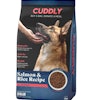
The global pet care market is growing. That’s not a surprise — it’s been the case for some time now — yet new data from NielsenIQ (NIQ) presented during Global Pet Expo 2025 offered some twists. For example:
- In 2024, Europe contributed the most to global pet care growth: 52%, vs. 33% for North America, the next largest contributor by region. The emerging regions of Latin America, Asia Pacific and Africa/Middle East contributed 6%, 1% and 9%, respectively. Europe and North America are the largest pet care and pet food regions by far, so it makes sense that their growth would contribute more to global growth; it’s just a change to see these developed regions outpacing the others in terms of growth.
- The ongoing rise in pet ownership among gen Z means households globally increasingly have a mix of types of pets. (The American Pet Products Association, organizer of Global Pet Expo, reported the same thing in their update on U.S. pet ownership.)
- Echoing data from other sources, NIQ reported that cats are leading the way in terms of pet ownership growth globally; in fact, more than one in four households worldwide now include a cat.
1 billion pets around the world
Sam Smith, associate client director, pet manufacturing and consumer product goods for NIQ, said the number of pets owned globally now numbers 1 billion, and pets are in 56.1% of households across 18 countries tracked by GFK Consumer Life, a division of NIQ.
Following a recent trend around the world, dog ownership is flat at 33.2% as of end of 2024, nearly the same as in 2019 (33.1%). Cat ownership, on the other hand, continues to rise; it’s now at 27.3%. up from 23.6% in 2019.
The data across the 18 countries also revealed 1.2 billion new pet shoppers in 2024. Overall, pet owners in these markets shop the pet retail market once every two to three weeks, spending an average of US$17 on three to four items with each shopping trip. This is in brick-and-mortar pet stores; pet owners shop online for only a quarter of their needs or “trips,” yet they spend twice as much and buy more units and three times the volume compared to in store. Bottom line, in store is for specific things and more frequent trips; online is for larger bulk purchases made less frequently, Smith said.
He also presented data showing inflation, including with pet food, is leveling out, represented by unit and volume sales flattening rather than declining; value sales are still increasing, though most of the growth is online. This tracks with nearly every other consumer product goods category: All continued strong online growth in 2024 while in-store sales were mostly flat or down. Interestingly, pet care is only about US$10 billion away from overtaking household care products in overall category sales, Smith commented.
Pet food ingredient deep dive
As goes human food, often so goes pet food, including with ingredients and label claims. Smith’s colleague, Hannah Polk, associate sales director, health and wellness attribution for NIQ, presented data showing that alignment. Many of consumers’ health priorities within human food spill over onto their pets’ food and other products. For example, mood and stress-related claims in pet food grew 8.2% in the U.S. in 2024 — not nearly as much as the 55% growth in such claims for human diet and nutrition, but still noteworthy.
Other “food as medicine” claims in pet care on the rise included hydration support, microbiome and heart, urinary tract and kidney health. Human-grade dog food claims also continued to increase, to the tune of 10.3% for dry dog food, 33% for wet and 12.8% for dog treats. Polk also shared growth data for usage of certain pet food ingredients, specifically vegetables like spinach and celery, and other materials like peanut butter.
Given the focus at the U.S. federal level on ridding foods of artificial dyes, especially red dye no. 3, Polk said only 1.1% of U.S. pet foods include that dye. However, other color additives appeared at higher percentages, adding up to 53.2% total usage in 2024 — meaning pet food manufacturers using these should be monitoring new regulations and directives.
When it comes to sustainability and all its many facets, pet food claims related to nature, climate, animal welfare and packaging sustainability all are growing at a higher rate than for pet care overall, except in the area of social responsibility.
Yet Polk also revealed just how far sustainable pet food packaging has to go, for example, compared with other consumer goods categories. While dog food packaging far surpasses that for ready-to-eat cereal, a US$26 billion market vs. US$9.7 billion, only 2% of dog food packaging carries a sustainability claim, compared to 57% for cereal. And 67 manufacturers in the cereal category are making sustainable packaging claims; it’s only slightly higher, at 73, for dog food despite the disparity in category size.
Causes, tariffs and regulations
My other observations from Global Pet Expo 2025:
- I didn’t see anything particularly innovative in the New Products section, but I did notice more pet treat and food brands and companies focused on causes, such as children’s health, animal health and well-being, the environment and people with disabilities.
- Impending tariffs were the subject of a special meeting among all pet-related associations (including some from outside the U.S.), pet food and product manufacturers and others. The purpose of the gathering was to start to form a proactive, collaborative plan for the industry — more to come on that soon.
- A panel discussion on new and proposed pet food regulations and ingredient approval processes indicated that, despite so much activity and uncertainty in Washington, D.C., some of these are continuing to move forward. Some, on the other hand, may depend on staffing and other changes at the Food and Drug Administration. Please stay tuned for more on that, too (and consider checking out a similar panel that will close out Petfood Forum 2025).

















